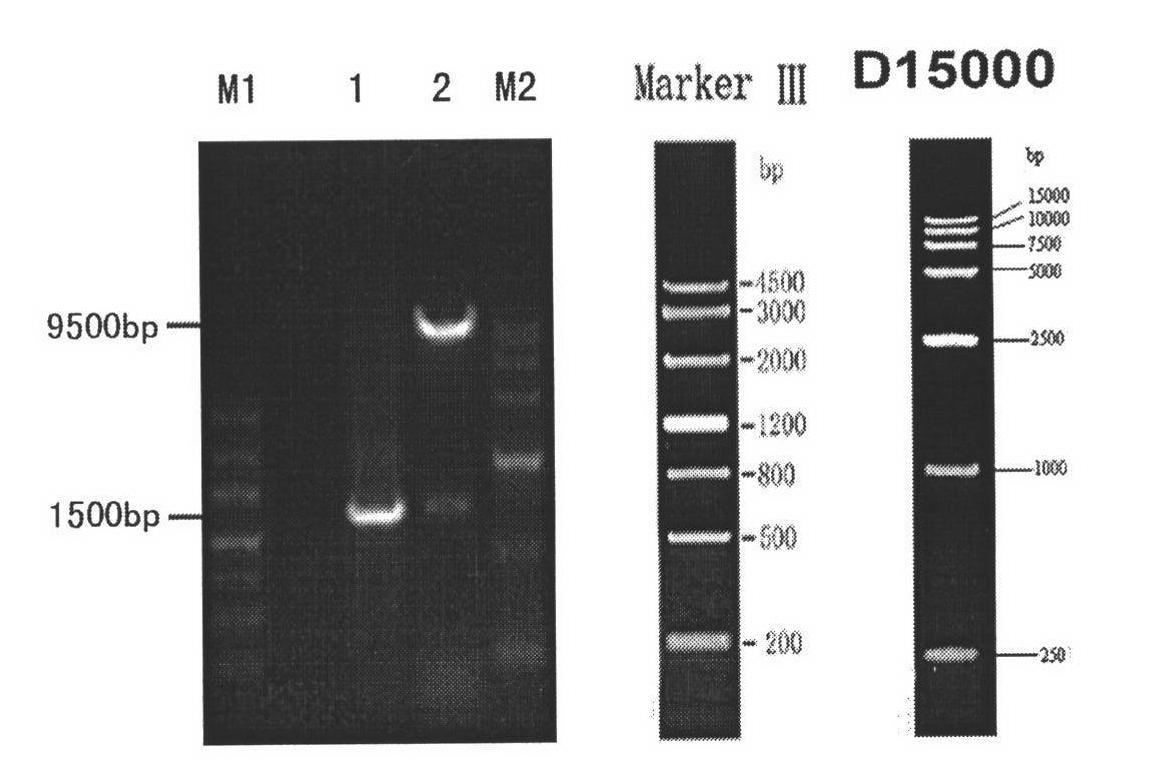Lycium chinense miller lycopene beta-cyclase gene, recombinant vector containing gene, host cell and application
A technology of lycopene and recombinant carrier, which is applied in the direction of introducing foreign genetic material and modifying cells, application, genetic engineering, etc., to meet nutritional needs and increase production
- Summary
- Abstract
- Description
- Claims
- Application Information
AI Technical Summary
Problems solved by technology
Method used
Image
Examples
Embodiment 1
[0050] For the experimental methods that do not specify specific conditions in the examples, usually follow the conventional conditions and the conditions described in the manual, or follow the conditions suggested by the manufacturer.
[0051] Cloning of lycopene β-cyclase gene LmLycB from Lycium barbarum:
[0052] With RNeasy Plant Mini Kit (QIAGEN, German) kit, Total RNA was extracted from 100 mg of fresh Lycium barbarum leaves. Amino Acid Sequence A degenerate primer P1 was designed, such as the sequence shown in SEQ ID NO.3 in the sequence listing. The complete gene sequence was amplified using the 3′-FULL RACE Core Set Ver.2.0 (TaKaRa, Japan) kit. Specific steps: ① Using Total RNA as a template, use 3′RACE Adapter primers for reverse transcription reaction to synthesize 1st Strand cDNA. The reaction system is as follows:
[0053] RNA: 2 μl
[0054] 3′ RACE Adaptor: 1 μl
[0055] 5×M-MLV Buffer: 2μl
[0056] dNTP Mixture: 1 μl
[0057] RNase Inhibitor: 0.25μl
[00...
Embodiment 2
[0072] Construction process of intermediate vector pBS-T-LmLycB
[0073] The LmLycB gene shown in SEQ ID NO.1 was connected to the pBS-T vector, and the reaction system was as follows:
[0074] Target PCR fragment: 3μl
[0075] pBS-T vector: 1 μl
[0076] 2×T4DNA Rapid Ligation Buffer: 5μl
[0077] T4DNA Ligase: 1μl
[0078] Reaction conditions: 23°C, 10 min. The ligation product was transformed into E-Coli.TOP10 and spread on LB plates containing ampicillin. PCR was carried out with the target gene as a primer (reaction conditions: 94°C, 3min; 94°C, 30sec; 54°C, 30sec; 72°C, 2min30sec; 72°C, 10min, 30 cycles.) to obtain a 1800bp product, and the extracted plasmids were subjected to BamHI Double enzyme digestion with PstI: 37°C, 16hrs, digestion (15μl plasmid DNA, 3μl R buffer, 0.5μl BamHI exonuclease, 0.5μl PstI exonuclease, 13μl ddH2O) to obtain the target band, and finally sent to Huada Gene Sequencing Company Sequencing results showed that the vector was constructed ...
Embodiment 3
[0080] Construction process of Escherichia coli expression vector pMON-LmLycB
[0081] First, use pBS-T-LmLycB as a template, and P3 and P4 as upstream and downstream primers to amplify the LmLycB fragment respectively. The reaction conditions are 94°C, 3min; 94°C, 30sec; 55°C, 30sec; 72°C, 2min30sec; 72°C , 10min, 30 cycles. A BamHI restriction site (GGATCC) and a base A were introduced into P3, and a SalI restriction site (GTCGAC) was introduced into P4. Then, the PCR product and the pMON38201 plasmid were digested with BamHI and SalI respectively, and the digested products were ligated: 16°C, 16hrs, ligation (2μl 10×T4buffer, 0.5μl T4DNA ligase, 5μl carrier DNA, 7.5μl exogenous DNA, 5 μl ddH 2 O). The ligation product was transformed into Ecoli.DH5α, and spread on the LB plate containing Amp, such as figure 1 Shown is the schematic diagram of the constructed pMON-LmLycB vector. PCR was performed with the target gene as a primer to obtain a 1500bp product, and the targe...
PUM
 Login to View More
Login to View More Abstract
Description
Claims
Application Information
 Login to View More
Login to View More - R&D Engineer
- R&D Manager
- IP Professional
- Industry Leading Data Capabilities
- Powerful AI technology
- Patent DNA Extraction
Browse by: Latest US Patents, China's latest patents, Technical Efficacy Thesaurus, Application Domain, Technology Topic, Popular Technical Reports.
© 2024 PatSnap. All rights reserved.Legal|Privacy policy|Modern Slavery Act Transparency Statement|Sitemap|About US| Contact US: help@patsnap.com










